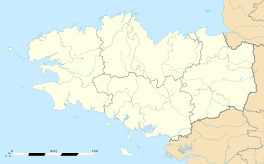Quimperlé
|
Quimperlé Kemperle |
||
|---|---|---|

Brémond d'Ars street
|
||
|
||
| Coordinates: 47°52′25″N 3°32′55″W / 47.8736°N 3.5486°WCoordinates: 47°52′25″N 3°32′55″W / 47.8736°N 3.5486°W | ||
| Country | France | |
| Region | Brittany | |
| Department | Finistère | |
| Arrondissement | Quimper | |
| Canton | Quimperlé | |
| Intercommunality | Pays de Quimperlé | |
| Government | ||
| • Mayor (2014–2020) | Michaël Qernez | |
| Area1 | 31.73 km2 (12.25 sq mi) | |
| Population (2013)2 | 11,978 | |
| • Density | 380/km2 (980/sq mi) | |
| Time zone | CET (UTC+1) | |
| • Summer (DST) | CEST (UTC+2) | |
| INSEE/Postal code | 29233 /29300 | |
| Elevation | 2–83 m (6.6–272.3 ft) | |
|
1 French Land Register data, which excludes lakes, ponds, glaciers > 1 km² (0.386 sq mi or 247 acres) and river estuaries. 2Population without double counting: residents of multiple communes (e.g., students and military personnel) only counted once. |
||
1 French Land Register data, which excludes lakes, ponds, glaciers > 1 km² (0.386 sq mi or 247 acres) and river estuaries.
Quimperlé (Breton: Kemperle) is a commune in the Finistère department of Brittany in northwestern France.
Quimperlé is in the southeast of Finistère, 20 km to the west of Lorient and 44 km to the east of Quimper. Historically, it belongs to Cornouaille. The town is situated at the confluence of the Isole and Ellé rivers that combine to form the Laïta river, hence its name: confluent (kemper-) of the Ellé (-le). A fourth smaller river, the Dourdu (black water in Breton), joins the Laïta downstream.
The city is traditionally divided in two parts, the High Town and the Lower Town. The Lower Town, in the valley, is the historical centre, and developed around the Saint-Colomban church (of which only the front wall remains) and the abbey of Sainte Croix (Holy Cross). It covers the land between the Ellé and Isole rivers as well as the banks of the Laïta, an area that is sometimes flooded.
The more modern High Town, in the plain above the valley, centres around the Saint-Michel church and its market square. Seen from the Lower Town, its "mountain" topped with the Saint-Michel church has earned Quimperlé the nickname of "Mount Saint Michel on land"
The town also developed, less importantly, on the East side of the valley, facing the Saint Michel mountain. This area is called Bourgneuf, a common name for recent neighbourhoods.
Inhabitants of Quimperlé are called in French Quimperlois.
It seems that the area was first inhabited by Neanderthals, since remains of Mousterian-style stone tools have been found in the forest between Quimperlé and Clohars-Carnoët. A few dolmens were erected in Quimperlé itself, although there is no trace of an actual settlement in the prehistoric times.
...
Wikipedia



